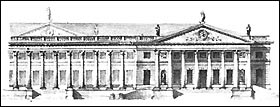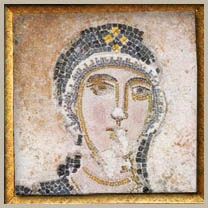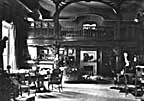History - A Short History of the Palace
Headline
Giacomo Quarenghi was the architect of the palace. He was born in Bergamo, Italy in 1744 and died in St. Petersburg in 1817. Quarenghi came from a family of artists. He was originally trained as a painter and had exceptional drawing abilities. He travelled throughout Italy, England and France studying architecture. Quarenghi had been deeply influenced by the Palladian style he saw in his native region around Venice during his youth. He was also impressed by the latest trends in Neo-classical architecture being built in France and the earlier, chaste designs of the English architect, Indigo Jones. Catherine invited Quarenghi to Russia in 1779, when he was thirty.
Physically Quarenghi was short and ugly. He was ridiculed by his critics for his height and appearance. He was clumsy and had a strange booming voice. Quarenghi had 13 children, some of whom lived in Russia and others who stayed in Italy.
Immediately upon his arrival in Russia the Tsarina put Quarenghi to work and commissioned many designs from him throughout her reign. He was one of her favorite architects. He was a master draughtsman and produced splendid sepia plans for the palace for Catherine which still survive.


Originally the Alexander Palace was planned for St. Petersburg. The first designs, (above) which were intended for an urban environment, clearly show a more ornate facade and a complex interior plan. At some point Catherine decided to build Alexander's palace in Tsarskoe Selo and simplify the plan. These changes went through several stages as plans for the palace neared reality.
Catherine selected a spot near her own residence in the Catherine Palace for the building. The site was a low hill on the other side of the palace park. Moving the location of the palace from the city to Tsarskoe Selo changed many of design requirements for the building. In Petersburg the palace had been designed a year-round Imperial residence; in Tsarskoe Selo the palace would function as a summer home, to be used only a few months out of the year. These circumstances reduced the need for expensive interiors and embellishments intended to impress the public. The palace plans were also modified to fit the more relaxed atmosphere of a summer residence.
Following the practice of the times, in 1792 the Imperial Court placed an advertisement in the St. Petersburg newspapers requesting bids from private contractors to build the palace. The selected firm was placed under the supervision of the Russian architect Nilov, who had been given the assignment of translating Quarenghi's designs into reality. He worked with Minchacci, Rusco and others. 286,000 rubles was paid to the contractor in installments which was to be fully paid by autumn of 1794. The building of the palace presented a number of challenges related to the site. Underground rivers which passed beneath the surface of the site caused the building to shift as it was going up. Major cracks developed in the main vault of the Semi-Circular Hall which can still be seen today. The builders made a number of on-the-spot changes to the design to accommodate problems like this that emerged during construction. A large terrace was built outside the garden entrance of the building to support and reinforce the vaults of the central halls. The contractors who put up the building had made a fixed bid for the construction. Delays and increased building costs came out of potential profits and they were anxious to put up the building as quickly and with as few complications as possible.
The palace foundations are of stone, but elsewhere the Alexander Palace is almost entirely constructed of brick. Millions were required to build the palace and they were made in the immediate vicinity of the of Tsarskoe Selo from local clays. This was a subject of some concern for Catherine. She strictly ordered the protection of local forests for fear the builders would strip the trees around Tsarskoe Selo to fire their kilns and possibly ruin her vistas.
The original bid for the construction of the building did not include funds for the interior decoration. The firm constructing the building did not have responsibility for the interiors and this assignment was given to an international team of British, Russian and Italian craftsmen. But as the construction of the building progressed Catherine found herself pressed for funds, and continued scaling back the interior decoration of the palace. This was not seen as a serious problem, the Empress felt Alexander could make his own additions later according to his own tastes.
Some furniture for the palace was ordered new, but most of it was assembled from other palaces. For example, a number of things were brought from the seldom-used Tauride Palace. Catherine made other selections for Alexander's palaces from her own residences.
At first, the exterior of the palace was left as exposed brick. It took a number of years for the brickwork to dry out and final stuccoing and painting could not safely occur for some years. The "New Palace", as it was then called, was completed and presented to Alexander in June 1796. He and his wife moved in on June 12, 1796. The construction had taken almost four years. Catherine greeted the then sixteen-year-old boy and his new wife, Elizabeth of Baden, on the steps of the palace with bread and salt, traditional gifts of blessing for a new house. Alexander had but a short time to enjoy the palace before the death of his grandmother in November of the same year. This event significantly changed the circumstances of his life and he came under the control of his father, the new Emperor Paul I.
During Paul's reign the palace was stuccoed and painted. It seems that the building was painted yellow and white from the beginning, although the original color was deeper and more intense that the hue we see today.
Paul was unpopular with a wide segment of society and was assassinated in the Mikhailovski Castle in St. Petersburg. Some claim Alexander was implicated in the murder, who then succeeded his father on the Russian throne. During his reign Alexander preferred to live in the Catherine Palace over the Alexander Palace when he was in Tsarskoe Selo. This does not mean he neglected the Alexander Palace, which required a great deal of maintenance in this period. In 1809 600,000 rubles had to be allocated for repairs to the building and the building's contents were fully inventoried for the first time.
Alexander and his wife were childless and he decided to designate his second brother, the future Nickolas I, to succeed him. He offered the Alexander Palace to Nickolas and began the tradition of making the Alexander Palace the Heir's semi-official summer palace in Tsarskoe Selo.
The palace retains the indelible mark of Nicholas I and his times. Nicholas had a large and growing family. Although he has a reputation for being a harsh ruler, when outside of governmental affairs he was a sentimental, family oriented man. The Alexander Palace was his favorite residence and he doted on the building, its furnishings and grounds. Many of the changes made to the palace reflect Nicholas' attitude toward the palace as his private home. For example he had special kitchens built within he palace so he could order favorite fast foods when he wanted them. He even did some of the cooking himself. Nicholas personally planted flower beds and made the final decision regarding the placement of each painting and piece of furniture. After becoming Tsar Nicholas' continued to favor the Alexander Palace and stayed there often.
Nicholas chose the Alexander Palace for some of the important events of his reign, including the first telegraph transmission in Russia, which the Tsar made from the palace.
Following in the footsteps of his elder brother, Nicholas gave the use of the Alexander Palace to his eldest son and heir, the future Alexander II, on the occasion of his marriage. This lead to a complete redecoration and updating of the palace. Technical advancements in lighting, heating and cooking meant changes went beyond simply new fabrics, furniture and carpets. The palace was completely modernized and brought up-to-date in the mid 1840's. Later in life, after her husband had become Tsar and taken on a mistress, Alexander's wife, the Hessian Princess Maria Alexandrovna, decided to live in the Alexander Palace year-round. This presented problems because the palace had been built as a summer residence. It lacked the double-paned windows and double floors necessary to keep a building warm during frigid Russian winters. New heating systems were installed in the parts of the palace occupied by the Tsarina.
As Tsarevich the future Tsar Alexander III and his wife Maria were presented the use of the Alexander Palace at their marriage by his father. His mother continued to live in the palace and Alexander's use of it was limited until her death in the palace. In 1874 a part of the palace was remodelled for the honeymoon of Alexander II's only daughter, Maria, to Alfred, the son of Queen Victoria of England.
Alexander III's wife Maria Fyodorovna loved the Alexander Palace passionately. She adored the parties and elegance of Tsarskoe Selo over the austerity of her husband's own preference, Gatchina. Two of Maria and Alexander's sons, the future Nicholas II and his brother George, were born in the palace. As they grew older both boys continued to have apartments in the palace and used them whenever they were in Tsarskoe Selo.
When Nicholas ascended the throne in 1894 he and his new wife Alexandra decided to make the Alexander Palace their principal residence. As a result, Nicholas II and his wife made the most significant changes to the building since the reign of Catherine the Great. Extensive renovations were made to the building and new systems, such as electricity, telephones, washing machines, elevators and flush toilets, were installed. One whole wing of the palace was completely redone in a strikingly domestic and luxurious way. Nicholas and Alexandra's principal objectives were to create a comfortable and elegant family home.
Later changes to the palace in the reign of Nicholas II included the erection of the two finest Imperial Art Nouveau interiors in Russia and delightful rooms created for the Tsar's children.
At the time of the Russian Revolution and the exile of the Romanov family to Siberia it was decided to convert the Tsar's palace into a museum which documented the life of the Romanovs in the palace throughout the 19th century . Naturally, the strongest emphasis was placed on events in the reign of Nicholas II. Soon after the departure of the Romanovs for Tobolsk in August 1917 parts of the palace were opened to the public by it's first curator, Lukomskii. After the murder of the Romanovs in Yekaterinburg in July 1918 some of their personal possessions that hand followed them to Siberia were returned.
The museum in the Alexander Palace showcased the interiors as closely as possible to their state in August 1917. They appeared as if the Tsar and his family had just left and might return at any moment. The tragedy of the story of the Romanovs and the intimacy of the private rooms created a lasting impression on those who saw them, creating sympathy for the Tsar and his family and this ran counter to the intentions of the Soviet Government. In 1919, soon after the Bolshevik coup, a part of the palace was converted into a Children's Colony, but this experiment proved to be a disaster and these rooms were returned to the museum. Extensive restoration enabled these rooms to be reopened to the public. In the mid-1920's Nicholas' and Alexandra's historic rooms in the Winter Place, which had been open as a part of the museum there, were closed and their furnishings disbursed. Some items were transferred to the rooms of the Alexander Palace where they were merged into the collection.
The Alexander Palace museum proved to be one of the most popular museums in Russia and was a must see for all foreigners who made it to the new Soviet state. Unfortunately, the government had an indifferent, even hostile attitude toward the "Romanov Museum". Officials began to pilfer objects and furnishings from the palace for sale to foreigners and for the use of party officials. Later the secret police demanded the use of a part of the palace as their private resort. In order to prepare for this transition these rooms were emptied of their contents and the treasures sold off in stores for foreigners in Russia and by Hammer in the USA.
Throughout the 1930's there were frequent threats by the government to close the rest of the museum and sell off its treasures. Somehow, the museum workers and public managed to dissuade the government from this step and the museum operated right up until the beginning of World War II.
At the outset of Hitler's declaration of war on the Soviet Union in 1941 the Director of the Alexander Palace Museum, A. M. Kuchumov, received orders to evacuate around 300 objects from the path of advancing German troops. This was a tiny selection from a collection totalling tens of thousands of objects. Frantically, and with great courage and improvisation, the museum workers were able to pack and ship out of harm's way a significant part of the museums' collection. Sadly, thousands of precious treasures and items of extraordinary historical value were left behind.
When the Germans occupied the town they immediately looted the palaces. What they didn't cart away for use in their military quarters was shipped off to Germany and Spain, where many of the palace treasures remain to this day. The palace itself was converted into an SS hospital and was heavily protected by German troops. An SS monument and graveyard decorated with Nazi symbols was erected in the palace courtyard. The palace was heavily damaged during the war by shell fire and reckless abuse by the Germans and their Spanish allies during their occupation.
Still, considering the ordeal it had been through after the war the palace was discovered by returning museum workers to be in remarkable shape. It was the best preserved of all of the suburban palaces that had been behind German lines and was chosen to become the depot for works of art returning from Siberia to Leningrad. Ambitious plans were made for the restoration of the palace as it had been before the war. At this point the government, perhaps Stalin himself, made a critical decision about the future of the palace - it was not to be a Romanov museum. The palace was to be stripped and restored as a generic 19th century palace - any restoration that presented the private lives of the last Tsar and his family were forbidden. This restoration began and interiors which had survived the German occupation were brutally stripped and destroyed. Before this work was completed Stalin changed his mind and made another decision that the museum was to be closed altogether and the building presented to the Navy for their use.
The invaluable and unique collection of the palace was dispersed among many museums. Pieces went to Pavlovsk, the Catherine Palace, the Hermitage and elsewhere. Most personal items associated with the last Tsar and his family were simply locked up and placed in indefinite storage.
In the late 1980's Suzanne Massie and Bob Atchison, with the blessing of the former curator of the Alexander Palace, A. M. Kuchumov, who had made the restoration of the palace as a museum his life's goal, appealed to the press and the city of Leningrad for the reestablishment the Alexander Palace Museum. This intense and exhausting effort proved successful and a government decision was made to re-establish the museum. The only stipulation was the successful relocation of the naval institution occupying the building to an acceptable location.
Work continued to make the museum a reality. Several years of research on the palace under the direction of Kuchumov were financed by Bob Atchison. In 1994 the Alexander Palace website was established to help promote interest in the monument. The results of the research are shared with the public for free on the website.
Please send your comments on this page and the Time Machine to boba@pallasweb.com













 Imperial Bedroom
Imperial Bedroom Portrait Hall
Portrait Hall Mauve Room
Mauve Room Maple Room
Maple Room Aleksey's Bedroom
Aleksey's Bedroom Nicholas's Study
Nicholas's Study Aleksey's Playroom
Aleksey's Playroom Formal Reception
Formal Reception Balcony View
Balcony View Aleksey- Balcony
Aleksey- Balcony Children-Mauve
Children-Mauve Nicholas's Bathroom
Nicholas's Bathroom Alexandra- Mauve
Alexandra- Mauve Nicholas's Reception
Nicholas's Reception Tsarskoe Selo Map
Tsarskoe Selo Map